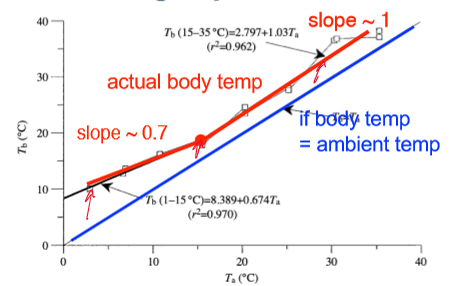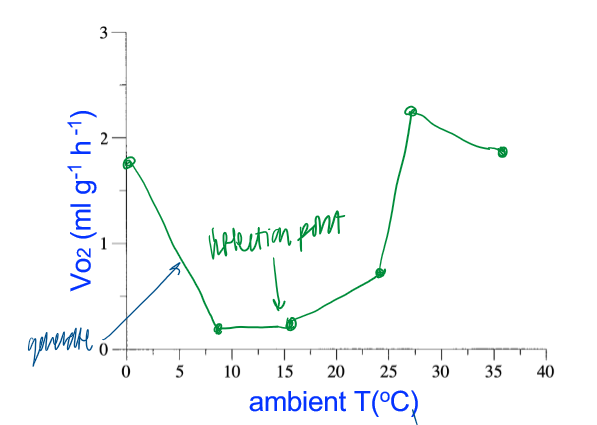E155 Why don’t bears lose muscle mass after hibernating for 3 months?
1/24
There's no tags or description
Looks like no tags are added yet.
Name | Mastery | Learn | Test | Matching | Spaced |
|---|
No study sessions yet.
25 Terms
What are some human diseases that might benefit from understanding the physiology of hibernation?
stroke, osteoporosis, Parkinson’s disease and Alzheimer’s
How are bears different from other hibernators?
Hardly lose any heat at all in their winter dens, but their metabolism still slows
Complete shutdown and resetting the parameter of their daily lives
Shut down genes involved with the breakdown of bone (can be used to prevent osteoporosis)
Stay insulated by their fur and fat
Bears decide when to shut down and when to recover (driven by food supply and temperature)
Describe the changes in body temperature during the winter for ground squirrels.
The body temperature dramatically decreases and peaks for a short amount of time at relatively consistent intervals
Arctic ground squirrels overwintering in frozen soils must defend themselves against large thermal gradients (or differences between ambient and body temperatures) while torpid using nonshivering thermogenesis (thermogenic torpor)
How is climate change affecting the start and end of the hibernation (torpor) period?
Climate change and global warming decreases the torpor period
Bears are hibernating for less time because the climate is warmer
According to the discussion, what is a potential benefit of climate change for ground squirrels?
Reduced intensity and/or duration of thermogenesis caused by warmer conditions would allow arctic ground squirrels to conserve energy and potentially increase winter survival
According to the discussion, what is a potential problem with climate change for ground squirrels?
Climate change could shorten the hibernation season and increase the number of days that arctic ground squirrels are active above ground, increasing mortality rates because of increased exposure to predators
In the section called “Morphological changes during hibernation”, how are changes in muscle mass in hibernators different from what happens in disease or atrophy? What muscle fiber type appears to be upregulated during hibernation?
Losses of muscle mass, protein, and fiber size are typically small during hibernation
Hibernators prevent alterations to muscle fiber type ratio that typically accompany inactivity; greater proportion of fast glycolytic muscle fibers
Marginal loss of oxidative type I fibers and a retention of fiber ratio throughout the winter
Moderate increase in type I slow oxidative fiber ratio during hibernation
Hibernators increase type I fiber ratio by 25% relative to fiber ratios during the summer active period
In the section called “Skeletal muscle contractile performance” what happens to muscle fiber strength during hibernation?
There is little loss in muscle strength over the hibernation period (average muscle strength is only reduced by 12.6%)
In the section called “PI3K/Akt/mTOR”, what happens to protein synthesis and degradation during hibernation?
Decrease in protein synthesis and protein degradation during individual torpor bouts
Net balance of protein synthesis and degradation
Bats have low rates of both during torpor, but rates comparable to summer levels during arousal bouts
In the section called “Myostatin”, what is a potential benefit of downregulating myostatin?
Myostatin: a transforming growth factor that prevents activation of Akt and reduces mTOR-induced protein synthesis
Downregulation during hibernation can preserve muscle mass
how does PGC-1α affect the production of slow oxidative muscle fibers (Type I)?
determines muscle fiber-type plasticity by enhancing the gene expression characteristic of slow oxidative fibers
Endurance training increases PGC-1α and expression of slow oxidative muscle fibers
Inactivity enhances the expression of fast glycolytic muscle fibers
Fasting and cold exposure increase expression due to increase in free fatty acids; active PPARS drives expression of slower, more oxidative muscle fibers
how does Ca2+ affect the production of slow oxidative muscle fibers (Type I)?
increase in muscle activity with shivering increases Ca2+ and the other pathways
how does AMPK affect the production of slow oxidative muscle fibers (Type I)?
relative expression increases during hibernation
How long do arctic squirrels hibernate?
8 months
What do they do while hibernating?
Decrease in HR
Decrease in respiration
how cold is the arctic squirrel burrow
-3 C
how do ectotherms maintain stability without generating heat
conduction = lay in burrow, posture
radiation = sun
brumation = low VO2 (cooling)
evaporation
hibernators are deliberately hypothermic
hibernation = body temps significant drop then increase daily torpor = decreased metabolic rate to save energy
bats and hummingbirds are
endothermic homeotherms
bats and hummingbirds in torpor
enter torpor at night
temp decreases during sleep and torpor
body and ambient temp of bats
body temperature = ambient temperature

VO2 and ambient temperature of bats
energy expenditure/VO2 is greatest at extremely low and high temps
low VO2 at optimal, moderate temps

waking up costs a lot of energy. what is the advantage of arctic ground squirrels waking up every 10-14 days?
restroom; protect neurons
potential mechanisms for bear hibernation
reduce oxidative stress and downregulate atrophy pathways
increasing pathways that maintain muscle
decreasing pathways for muscle atrophy
Pl3K/Akt/mTOR pathway for cell survival
limiting apoptosis (cell death)
altering mRNA translation, cell cycle entry, angiogenesis